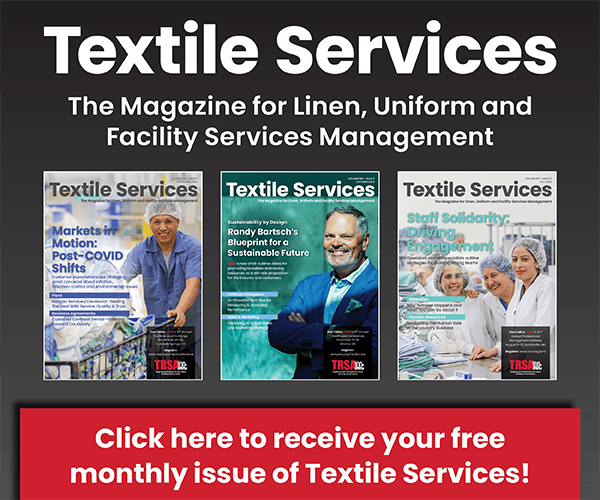Employees in linen, uniform and facility services plants sometimes will encounter risks that require the use of personal protective equipment (PPE) to prevent workplace illnesses and injuries. The key information that laundry employees need to know is what types of PPE they should wear and in what locations. The Occupational Safety and Health Administration (OSHA) has rules governing the use of PPE in laundry environments. Highlights of those rules and best practices for using PPE for employee safety appear below.
Definition & Guidelines for Use
PPE is equipment worn to minimize exposure to hazards that may cause serious workplace injuries or illnesses. In a linen, uniform or facility services plant, employees may encounter different hazards that will require PPE. Supervisors are responsible for informing staff where and when PPE is required. Examples appear below:
- Employees must always wear gloves, eye protection or face shields when handling chemicals or touching potentially contaminated items.
- Managers must provide headcovers where required.
- Employees working in the soil-sort area must wear gowns. They may discard or place these items in a soiled textile receptacle after each use.
- Other work functions will require the use of PPE such as ear plugs, hard hats, harnesses, etc.
- PPE must fit properly and be worn at all times.
Additional PPE Guidelines
- Managers must demonstrate to employees the proper way to don PPE.
- Employees must wear their PPE correctly for the duration of work.
- Reusable PPE (e.g., aprons) that are penetrated by blood or other potentially infectious materials (OPIM) must be removed immediately or as soon as feasible.
- After removal, employees must place PPE in an appropriate receptacle before leaving the work area.
- Employees must change PPE if they’re moving from an area where soiled operations were performed into an area where clean operations are performed.
- Employees must wear dedicated shoes and/or disposable shoe covers in the surgical pack assembly room.
Types of Commonly Used PPE
- Eye Protection/Face Shields: protect eyes and face from infectious materials, or other hazards, including potential contact with blood, bodily fluids or OPIM.
- Gowns: Employees wear gowns to reduce the spread of infectious materials that can cause diseases. Managers must ensure that employee gowns are worn properly during use to prevent the spread of infectious materials.
- Gloves: Employees wear gloves to create a barrier that prevents contamination of hands. Gloves can help reduce the spread of pathogens only if used properly.
Employee PPE Do’s and Don’ts
Do:
- Ensure proper PPE for employees in their work areas.
- Employees should hold others accountable for PPE
- Managers must ensure that all PPE are clean/usable.
- Managers must notify staff if new PPE are needed.
Don’t:
- Employees should never wear unauthorized PPE.
- Work in areas without all of the required PPE.
- Wear PPE when leaving the work area.
- Leave work area without washing your hands.
Understanding the importance of PPE and ensuring that employees use it appropriately at all times when needed is critical to minimizing the risk of workplace injuries and illnesses stemming from exposure to infectious materials or chemical or other hazards. TS




